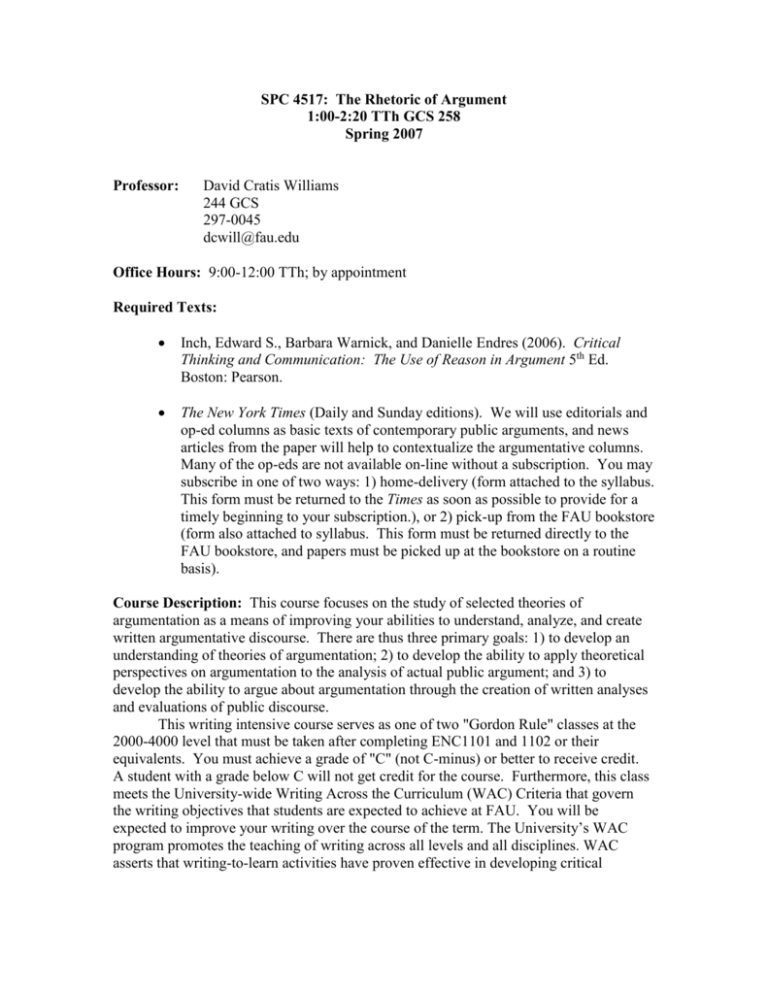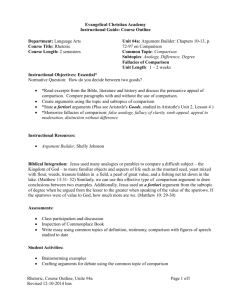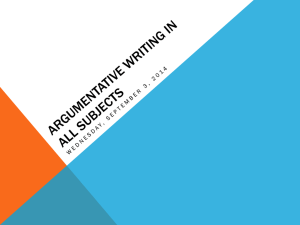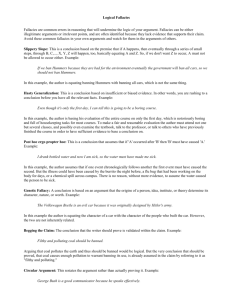SPC 4517: The Rhetoric of Argument
advertisement

SPC 4517: The Rhetoric of Argument 1:00-2:20 TTh GCS 258 Spring 2007 Professor: David Cratis Williams 244 GCS 297-0045 dcwill@fau.edu Office Hours: 9:00-12:00 TTh; by appointment Required Texts: Inch, Edward S., Barbara Warnick, and Danielle Endres (2006). Critical Thinking and Communication: The Use of Reason in Argument 5th Ed. Boston: Pearson. The New York Times (Daily and Sunday editions). We will use editorials and op-ed columns as basic texts of contemporary public arguments, and news articles from the paper will help to contextualize the argumentative columns. Many of the op-eds are not available on-line without a subscription. You may subscribe in one of two ways: 1) home-delivery (form attached to the syllabus. This form must be returned to the Times as soon as possible to provide for a timely beginning to your subscription.), or 2) pick-up from the FAU bookstore (form also attached to syllabus. This form must be returned directly to the FAU bookstore, and papers must be picked up at the bookstore on a routine basis). Course Description: This course focuses on the study of selected theories of argumentation as a means of improving your abilities to understand, analyze, and create written argumentative discourse. There are thus three primary goals: 1) to develop an understanding of theories of argumentation; 2) to develop the ability to apply theoretical perspectives on argumentation to the analysis of actual public argument; and 3) to develop the ability to argue about argumentation through the creation of written analyses and evaluations of public discourse. This writing intensive course serves as one of two "Gordon Rule" classes at the 2000-4000 level that must be taken after completing ENC1101 and 1102 or their equivalents. You must achieve a grade of "C" (not C-minus) or better to receive credit. A student with a grade below C will not get credit for the course. Furthermore, this class meets the University-wide Writing Across the Curriculum (WAC) Criteria that govern the writing objectives that students are expected to achieve at FAU. You will be expected to improve your writing over the course of the term. The University’s WAC program promotes the teaching of writing across all levels and all disciplines. WAC asserts that writing-to-learn activities have proven effective in developing critical thinking skills, learning discipline-specific content, and understanding and building competence in the modes of inquiry and writing for various disciplines and professions. Class Policies: Productive class discussion depends upon both openness and mutual respect. You are expected to approach this class in a mature and honest manner. Some of the materials examined in this class are of a controversial nature, and sharp disagreements are likely to occur. Just as you would like for your attitudes and interpretations to be considered seriously by others, so too must you respect divergent opinions of others. Late work will not be accepted unless specific arrangements are made in advance. If you will miss a class assignment because of a University-approved absence, you must inform me of that in advance, with proper documentation, and make arrangements for fulfilling your class obligations. Should an emergency arise, please email or telephone me informing me of your status. Unless such arrangements are made, make-up work will not be accepted. “Extra-credit” or bonus points are not available; you will be evaluated based upon the assignments specified in this syllabus. Cell phones, pagers, etc., must all be turned off prior to class and may not be turned on again until after class is over. This is in accordance with university policy (2006-2007 FAU Undergraduate Catalog, p. 57). Class lectures and/or presentations may not be audio or video taped without specific permission in advance in each instance, and under no circumstances may tapes be made for anything other than explicitly pedagogical and educational purposes and uses. Plagiarism or other forms of academic misconduct, including cheating or aiding and abetting cheating, are serious offenses, and violations of prohibitions on plagiarism and cheating will result automatically in a failing grade for the course. Downloading and use of information or text of any form from the internet without appropriate quotation and source citation constitutes plagiarism. The professor reserves the right to ‘text-check’ any or all papers through plagiarism check web resources such as Turnitin.com. By taking this class, you agree that all required papers may be subject to such verification procedures for detection of plagiarism. Additionally, any cheating or plagiarism violations must also be reported to the University Committee on Academic Conduct. If you have questions about citation of sources, use of quotations, or other concerns about proper documentation, please consult with appropriate style sheets (for MLA style, see http://www.zbths.org/academics/mla_style_sheet/ ; for APA style, see http://owl.english.purdue.edu/handouts/research/r_apa.html) or with me. If you have questions about regulations concerning academic misconduct, please consult the 2006-2007 FAU Undergraduate Catalog, pp. 70-71. Students are encouraged to make use of the University Center for Excellence in Writing. They can help with writing difficulties (or just polishing writing style) as well as with research and documentation questions. For more information, please consult: http://www.fau.edu/UCEW/ Application of Americans with Disabilities Act: In accordance with University policy and the ADA, should you require individual accommodation to enable fulfillment of course requirements you must first register with the FAU Office for Students with Disabilities (561-297-3880), and you must notify me of your requirements immediately. Additional information is available at www.osd.fau.edu. Assignments and Expectations: Attendance and class participation: Attendance and class participation are expected. Consequently, after three absences from a scheduled class meeting, each additional absence will result in a half-letter grade reduction in your final grade, unless the additional absence is excused (and documentation of the excuse is provided). Punctuality is also expected; repeated tardiness will also result in a grade reduction. Active class participation is encouraged. Engaged attendance is the objective, and it will be rewarded. Examinations: There are two in-class examinations. These will be a mixture of short answer and multiple choice formats. Examination will be gone over in class; however, the examinations will not be returned. Papers: Assignments for papers will be discussed in class in more detail immediately prior to each assignment; supplemental instruction sheets may be handed out. Following each assignment, time will be taken in class to discuss major writing problems that were noted on the papers. Individual feedback will come in the form of comments and corrections on the papers themselves. 1. Application of Toulmin Model to Contemporary Public Argument (3-5 pages): using either an editorial or an op-ed column in The New York Times as your basic text, apply the Toulmin model as a way of diagramming the argumentative structure of the article. In your essay, you should 1) outline the basic argumentative structure of the Toulmin model; 2) apply the framework of the model to the essay you are analyzing, clearly indicating the argumentative function(s) of each major portion of the essay; and 3) justify your analysis (i.e., by presenting arguments supporting the cogency and accuracy of you analysis). 2. Recognition of Fallacies (2-4 pages): using either an editorial or an op-ed column in The New York Times as your basic text, identify fallacies present in the article (there must be at least two of them). In your essay, you should: 1) identify fallacious moves made in the article; 2) define and label those fallacies; and 3) assess the importance of the fallacious moves to the overall argumentative force of the article. In doing the latter step, you should offer a “tree diagram” of the main argument and supporting argument chains. That is, analyze the argumentative significance of the fallacies in the context of the overall argument structure. Your paper should advance both a series of designative claims (e.g., the article being studied commits these fallacies) and an evaluative claim in which you assess the ultimate worth of the argument given the fallacies. Your central claim is ultimately the evaluative claim, supported in part by the designative claims. Your central claim (or thesis) should for purposes of this paper be italicized. The italicized thesis sentence will help me to recognize whether you understand how to construct a thesis statement. Please attach a copy of the article that you a analyzing to your paper. 3. Parsing an Argument (4-6 pages): using either an editorial or an op-ed column in The New York Times as your basic text, you should first break the argument offered down into its component parts (claims, reasons, evidence) and then analyze the cogency of the argument. In your essay, you should 1) identify the major claim(s) advanced in the article, including identification of the type of claim(s); 2) identify and evaluate the sufficiency, relevance, and cogency of evidence and reasoning offered in support of the claim(s); and 3) identify the structural relationships among various claims (e.g., simple, compound, etc.). One of the keys to this assignment will be your structural analysis of the extended argument; that is, what is the thesis claim? What are subsidiary claims? How do they relate? 4. Ethical Evaluation of an Argument (3-5 pages): using either an editorial or an op-ed column in The New York Times as your basic text, you should first analyze the structure and soundness of the argument and then advance an ethical evaluation of the argument. In your essay, you should 1) identify the major and supporting claims advanced in the article; 2) analyze both the argumentative support for the claims and, if relevant, the relationship among claims advanced; and 3) evaluate the ethics of both the claim(s) advanced and the argumentative moves made to advance the claim(s). In your ethical evaluation, you should specify clearly the ethical criteria by which you are rendering your evaluation. 5. Argumentative Analysis Case Study: Draft One (8-12 pages): using editorials, op-ed columns, and/or letters-to-the-editor in The New York Times as your basic text (supplemented as need be by other sources), analyze the public arguments advanced concerning at least one major claim about a controversial issue. In your essay, you should 1) reconstruct the basic “case” being advanced in support of the claim(s); 2) analyze the argumentative structure of that case; 3) assess the evidence and reasoning (and fallacies) used to support the claim(s) and/or to refute counter-claims; and 4) evaluate the “case” both in terms of its argumentative cogency/soundness and its ethics. Please turn in five copies of your paper. 6. Argumentative Analysis Case Study: Draft Two (8-12 pages): based upon both peer review and professorial feedback, this is a polished revision of Draft One. Turn in one copy only. Grading Weights of Assignments Examination One Examination Two Paper One Paper Two Paper Three Paper Four Paper Five Paper Six Attendance and Participation Grading Scale: A+ 99-100 B+ 87-89 C+ 77-79 D+ 67-69 F below 60 A B C D 15% 10% 10% 10% 10% 10% 10% 20% 05% 94-98 84-86 74-76 64-66 ABCD- 90-93 80-83 70-73 60-63 Revised Daily Schedule SPC 4517: The Rhetoric of Argument 1:00-2:20 TTh GCS 258 Spring 2007 Jan. 9T 11Th Distribution of Syllabus Orientation to the Study of Argumentation Before class read: Inch, Warnick, and Endress, Chapter One 16T Approaches to Argumentation: Logical, Dialectical, and Rhetorical Before class read: Inch, Warnick, and Endress, pp. 30-38 18Th Introduction to the Toulmin Model for diagramming arguments Before class read: Inch, Warnick, and Endress, pp 38-44 By now, you should be receiving and reading on a daily basis The New York Times 23T The Co-Orientational Approach Before class read: Inch, Warnick, and Endress, pp 44-61 Feb. 25Th Argument Structures and Fallacies Before class read: Inch, Warnick, and Endress, Chapter Three Due: Paper One: Application of Toulmin Model to Contemporary Public Argument 30T Focus on Fallacies 1Th Fallacies Recognition Work Session 6T In-Class Review Session 8Th Examination One 13T Argument Claims and Propositions Return and Review Examination One Before class read: Inch, Warnick, and Endress, Chapter Four Due: Paper Two: Recognition of Fallacies 15Th Evidence Before class read: Inch, Warnick, and Endress, Chapter Five 20T Reasoning Before class read: Inch, Warnick, and Endress, Chapter Six 22Th In-class exercise: Argument Structures, Argumentative Claims, Evidence and Reasoning Return Paper Two: In-class discussion of major writing issues 27T Mr. Principles of Case Construction: Making Arguments about Arguments Before class read: Inch, Warnick, and Endress, Chapter Seven Due: Paper Three: Parsing an Argument 1Th In-class review of Paper Three: Toward Improving Your Own Arguments 6T 8Th Spring Break Spring Break 13T Argumentation and Ethics Before class read: Inch, Warnick, and Endress, Chapter Eleven 15Th Ethical Evaluation of Arguments 20T Analyzing Arguments about Claims of Fact Before class read: Inch, Warnick, and Endress, Chapter Seven 22Th Analyzing Arguments about Claims of Value Before class read: Inch, Warnick, and Endress, Chapter Eight Due: Paper Four: Ethical Evaluation of an Argument April 27T Analyzing Arguments about Claims of Policy Before class read: Inch, Warnick, and Endress, Chapter Nine 29Th Case Study: Arguments about School Mascots 3T Case Study: Arguments about School Mascots Discussion of Writing Issues encountered in Paper Four Formation of Peer Review Groups 5Th Case Study: Arguments about School Mascots Due: Paper Five: Argumentative Analysis Case Study: Draft One 10T 12Th Peer Review Sessions In-Class Paper Reviews 17T 19Th In-Class Review Session Examination Two 24T Last Class Due: Paper Six: Argumentative Analysis Case Study: Draft Two








